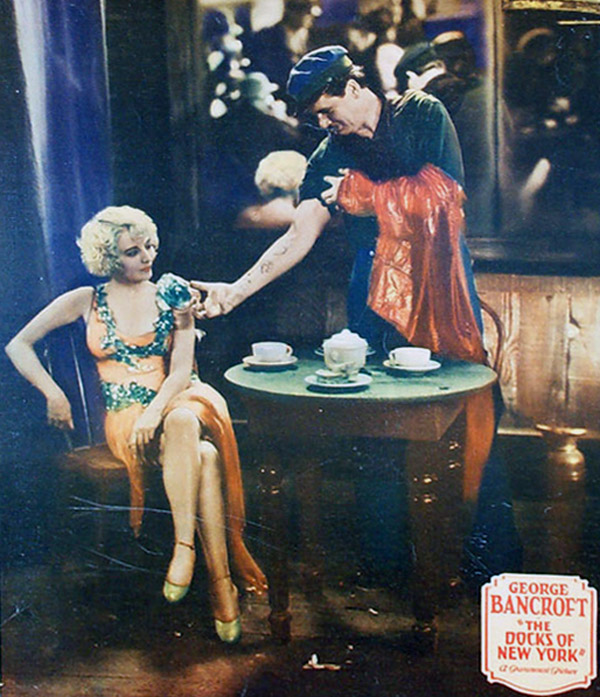What happens when an artsy director takes on a genre picture? Say, a tough waterfront melodrama where a burly stoker meets a gal? You get this:

Consider the names and history packed in that simple title card. Nowadays everyone would have to have his own production company with a 7 second computer-generated logo, but those were simpler times. Zukor co-founded Paramount - but first he founded Famous Players, which mergrd with Jesse Lasky's production outfit to form Famous Players - Lasky, which shows up at the bottom in tiny type here as "Paramous Famous Lasky Corporation." Got that?
As for Mr. Schulberg, wikipedia notes:
Born Percival Schulberg in Bridgeport, Connecticut, he took the name Benjamin from the boy in front of him when registering for school to avoid mockery for his British name. Schulberg, who started as a publicity manager at Famous Players-Lasky, but in the power struggle around the formation of United Artists ended up on the losing side and lost his job.
United Artists: there's a story for another day. Schulberg, of course, was the father of Budd, the accomplished screenwriter and novelist.
Sternberg was more than a prodcer - he was the director. This is pre-Dietrich. Seven years after this movie was made, Von Sternberg would hire Richard Neutra to design his house. (Ayn Rand lived tere for a while in the 40s.) Wikipedia:
Neutra was mindful of his customer's desires even when he found them absurd. He would later regale his friends with the story (among others) of Von Sternberg asking that none of the bathroom doors have locks, in order to prevent his party guests from locking themselves up in there and threatening to commit suicide.
More on the house here. Second title card:

Furthman wrote many films, including "The Big Sleep." Saunders was born in Minnesota, and not only wrote novels but penned the scrupt of "Wings," the first movie to get the "Best Picture" Oscar. He divorced Fay Wray in '39 and hung himself in '40.
Julian Johnson, who wrote the titles, was married to Texas Guinan for a while.
On to the actors. There’s nothing unusual, or particularly interesting, in the story. Boy meets girls when she throws herself in the drink. In this case, the boy is about the grimiest manly man whatever strode though a flicker:


George Bancroft. He had a good run in the silents as a rugged type. Known for a substantial ego.
The print of the movie is excellent, which reminds you that people in the 20s saw movies

Baclanova:

She's one of the hookers in the bar, the second female lead. She's not the hooker the hero saves; that would be . . .

Betty Compson. She went from playing alongside Roscoe Arbuckle in one- and two-reelers to top-star status, earning five grand a week. And more: imdb says
Compson was sent a 1912 Rolls-Royce by a South American who had it stored in a New York garage. As she already had a limo, she was initially annoyed but later discovered she could rent it to the movie studios at $100 per day. She ultimately made $20,000 on it before selling it. This situation may have been the inspiration for a similar situation in "Sunset Boulevard.".
Alas, you can't stay on top forever.
The stature of her roles began to diminish from the mid-1930's, though she continued to act in character parts until 1948. Betty's personal fortunes also declined. This came about primarily as a result of her marital contract to the alcoholic Cruze, whom she had divorced in 1929 . For several years, Cruze had failed to pay his income tax and Betty (linked financially to Cruze) ended up being sued by the Federal Government to the tune of $150,000.
This forced her to sell her Hollywood villa, her cars and her antiques. In later years, Betty Compson developed her own a cosmetics label and ran a business in California, producing personalised ashtrays for the hospitality industry.
The company was called "Ashtrays Unlimited."
This shot . . .

. . . appears to be this, from a lobby card.

(Peculiar, almost spooky sidenote: I snipped that grab above before I'd seen the title card.)
There's a preacher in the movie, Hymn-book Harry:

Gustav von Seyffertitz. Early in his career - he went into movies in middle-age - he went by other names that sounded more English. Like "G. Butler Clonblough" and "G. Butler Clonebaugh."
There are a few exterior shots, but most of the movie takes place in the bar, or in cheap lodging rooms. There's little of the big overacting people associate with silents, and every time the camera alights on a new face, the decades fall away - and the shadows come back to life again.

|